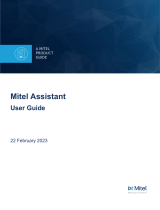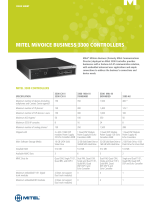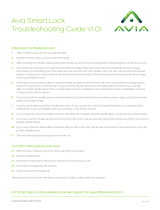
DSP-1282 & DSP-1283
Crestron Avia™ DSP with
Mitel® 8.0 PR3 Platform
Configuration Guide
Crestron Electronics, Inc.

The product warranty can be found at www.crestron.com/warranty.
The specific patents that cover Crestron products are listed at patents.crestron.com.
Certain Crestron products contain open source software. For specific information, visit www.crestron.com/opensource.
Crestron, the Crestron logo, Crestron Avia, and Crestron Toolbox are either trademarks or registered trademarks of
Crestron Electronics, Inc. in the United States and/or other countries. Mitel is either a trademark or registered trademark
of Mitel Networks Corporation in the United States and/or other countries. Other trademarks, registered trademarks,
and trade names may be used in this document to refer to either the entities claiming the marks and names or their
products. Crestron disclaims any proprietary interest in the marks and names of others. Crestron is not responsible for
errors in typography or photography.
©2018 Crestron Electronics, Inc.

Contents
Introduction 1
Audience 1
Topology 1
Software Requirements 2
Hardware Requirements 2
Product Description 2
Summary 2
Crestron Avia DSP Configuration 4
Connections 4
Device Discovery/Access 4
Device Configuration 4
Configure the DSP Device 4
Configure the SIP Parameters 7
Mitel Configuration 8
Verify Licenses 8
Configure Codec Settings and Network Zones 9
Configure Network Element 10
Configure Class of Service 11
Configure SIP Device Capabilities 20
Configure Trunk Attributes 22
Configure SIPPeer Profile 23
Assign SIP Peer Profile by Incoming DID 28
Automatic Route Selection (ARS) Digit Modification Number 28
ARS Routes 29
ARS Digits Dialed 30
Configure a User for Each Device/Phone 31
Configure a Call Forwarding Profile 36
Configure the Ring Group 37
Configuration Guide — 8341B Contents • i

ii • Contents Configuration Guide — 8341B

Configuration Guide — 8341B DSP-1282 & DSP-1283: SIP Endpoint with Mitel 8.0 PR3 • 1
DSP-1282 & DSP-1283:
SIP Endpoint with Mitel® 8.0 PR3
Platform
Introduction
This configuration guide describes the procedures required to configure Crestron Avia™
Digital Signal Processor (DSP) devices. The devices operate on the MiVoice Business (Mitel®
PBX) as basic Session Initiation Protocol (SIP) users.
Audience
The intended audience includes those attempting to configure and use Crestron Avia DSP
devices as SIP endpoints registered to MiVoice Business (Mitel PBX).
Topology
The diagram below shows the network topology for integration of a Crestron Avia DSP
endpoint with MiVoice Business (Mitel PBX).
SIP Endpoint Integration with MiVoice Business (Mitel PBX) - Reference Network

2 • DSP-1282 & DSP-1283: SIP Endpoint with Mitel 8.0 PR3 Configuration Guide — 8341B
The lab network consists of the following components:
l Mitel PBX
l Mitel phones
l Crestron Avia DSP as SIP users
Software Requirements
l MiVoice Business (Mitel PBX): 8.0 PR3
l Crestron Avia DSP: v1.00.121
Hardware Requirements
l MiVoice Business (Mitel PBX) either in a virtual environment or with a hardware
server
l Public Switched Telephone Network (PSTN) gateway
l MiTel Phones - 5360 IP phones (2)
l Crestron Avia DSP devices (2)
Product Description
The Crestron Avia DSP products (DSP-1282 and DSP-1283, specifically) consist of a family
of programmable digital audio signal processors intended for the commercial sound
market. Each version provides 12 analog mic/line inputs and eight analog line outputs. The
devices include a Local Area Network (LAN) connection and a Universal Serial Bus (USB)
connection for programming and control. The programmable signal flow is a fixed
topology with user-configurable input and output processing chains using a library of
preset signal-specific DSP blocks.
Use the Crestron Avia tool to control and configure the Crestron Avia DSP devices on the
network.
Use the Crestron Toolbox™ software to discover and control all Crestron devices on the
network.
Summary
This document describes how to configure the Crestron Avia DSP devices as SIPusers. It
also provides information on how to register devices to the Mitel PBX with digest
authentication.
Supported features include:
l Registration with digest authentication
l Basic calls with G711u and G711a codecs
l Dual-Tone Multi-Frequency (DTMF) support
l Early media support

Configuration Guide — 8341B DSP-1282 & DSP-1283: SIP Endpoint with Mitel 8.0 PR3 • 3
l Retrieval of a parked call
l Transferee in a call transfer
l Conference participant
l Member of hunt group
l DND (Do Not Disturb)
Unsupported features include:
l Caller ID presentation
l Call hold and resume
l Call forwarding on the device (forwarding can be configured on the Private Branch
Exchange (PBX) for the Domain Name (DN) assigned to the endpoint)
l Call waiting
l Initiating conference
l Initiating an attended call transfer
l Initiating an early attended call transfer
l Initiating a blind call transfer
l Shared line (configuration of shared line on device)
l Initiating call park
l Message Waiting Indicator (MWI)
Known issues and limitations include:
l The DSP does not support Music on Hold when integrated with the Mitel PBX.
l No support for caller IDon the Crestron Avia DSP.
l No support for MWI on the Crestron Avia DSP.
l When registered to Mitel, the DSP is not available to accept calls after a power cycle
unless the previous call is disconnected.
l In a Mitel environment, a call declined by the DSP does not provide appropriate
treatment to the calling party.
l The DSP fails to play a reorder tone when a call from the DSP to a PBX extension
eventually times out after the called party does not answer.

4 • DSP-1282 & DSP-1283: SIP Endpoint with Mitel 8.0 PR3 Configuration Guide — 8341B
Crestron Avia DSP Configuration
This section provides the following details:
l How to set up connections to the amplifier and speaker
l How to access the DSP on the network (once powered)
l How to configure the DSP for registration and integration with the Mitel PBX
Connections
Make the following connections:
l Connect microphone to DSP MIC/LINE INPUTS port 1
l Connect DSP LINE OUTPUTS port 1 to "Audio In" on amplifier
l Connect "Audio Out" of amplifier to speaker
l Connect LAN port to network
l Connect VOIP port to network
Device Discovery/Access
Use the Crestron Toolbox and the Crestron Avia tool to discover and access the connected
LAN and/or VOIP ports) DSP devices.
Use the Help menu to assist when performing the discovery and configuration procedure.
Device Configuration
The basic setup for a phone call requires:
l An analog input (such as from a microphone) routed out through the phone line
l Audio coming in from the phone line routed to an analog output (such as to an
amplifier or speaker)
Configure the DSP Device
Use the Crestron Avia tool to select and configure the DSP device.

Configuration Guide — 8341B DSP-1282 & DSP-1283: SIP Endpoint with Mitel 8.0 PR3 • 5
Input Configuration
To configure the analog input:
1. Click Signal.
Crestron Avia tool: Audio Input Configuration (1/4)
2. Under Analog In 1 (first row), double click Gain. In the new window set the following:
a. Click Mute to Off.
b. Select 33 for the Analog Gain.
c. If a condenser microphone is being used, click +48V (phantom power) to On.
Crestron Avia Tool: Audio Input Configuration (2/4)
3. Under Analog In 1 (first row), click Ref/Phone Out (right-most column) and enter 0
as the decibel value.
Crestron Avia Tool: Audio Input Configuration (3/4)
4. Under Phone\Sig Gen In, click PHN. In the new window set the following:
a. Move the Send Level slider to 0 db.
b. Click Mute to Off.
Crestron Avia Tool: Audio Input Configuration (4/4)

6 • DSP-1282 & DSP-1283: SIP Endpoint with Mitel 8.0 PR3 Configuration Guide — 8341B
Output Configuration
To configure the analog output:
1. Under Phone In 1 (first row), click Analog Out (left-most column) and enter 0 as the
decibel value.
Crestron Avia Tool: Audio Output Configuration (1/3)
2. Under Analog Out 1, double click LVL. In the new window set the following:
a. Move the Level slider to 0 db.
b. Click Mute to Off.
Crestron Avia Tool: Audio Output Configuration (2/3)
3. Under Phone\Sig Gen In, click PHN. In the new window set the following:
a. Move the Receive Level slider to 0 db.
b. Click Mute to Off.
Crestron Avia Tool: Audio Output Configuration (3/3)

Configuration Guide — 8341B DSP-1282 & DSP-1283: SIP Endpoint with Mitel 8.0 PR3 • 7
Configure the SIP Parameters
From the open PHN - In 1 - Phone Receive window, select and configure the SIP
parameters.
1. With SIP selected, click the chevron at the right top corner to expand the window.
Crestron Avia Tool: Phone Dialer, SIP Parameters Configuration
2. Enter the extension configured on Mitel for the Local Extension for this device. This
example uses 5000.
3. Enter the Mitel PBX for the SIP Server IP Address. This example uses 10.35.32.2.
4. Enter the SIP server port (5060) for the Port.
5. Enter the same end user name configured for the Mitel PBX with the digest
authentication credentials for the SIP Server User Name..
6. Enter the same password as configured for the Mitel PBX end user digest
credentials for the SIP Server Password.

8 • DSP-1282 & DSP-1283: SIP Endpoint with Mitel 8.0 PR3 Configuration Guide — 8341B
Mitel Configuration
This section describes the MiVoice Business system (Mitel PBX) configuration necessary to
support registration of Crestron devices and connectivity to Public Switched Telephone
Network (PSTN).
NOTE: Confirm that the general installation and basic Mitel configuration have been
administered.
Verify Licenses
Ensure that adequate licenses are available in the MiVoice Business System to support the
Mitel phones and Crestron devices.
Click Licenses > License and Option Selection in the MiVoice Business controller. Each
Crestron device uses one IPuser license.
Mitel: License Verification

Configuration Guide — 8341B DSP-1282 & DSP-1283: SIP Endpoint with Mitel 8.0 PR3 • 9
Configure Codec Settings and Network Zones
Configure codec settings to allow G711u and G711a codec negotiation.
Click Voice Network > Codec Settings and configure the codec filtering as shown.
Mitel: Codec Settings
NOTE: By default, use zone 1 to negotiate G711u as the preferred codec.
To configure Network Zone 1 to offer G711u as the preferred codec:
1. Click Voice Network > Network Zones.
Mitel: Configure Network Zones
2. Select a Zone ID to modify. This example uses 1.
3. Select No for the Intra-zone Compression.

10 • DSP-1282 & DSP-1283: SIP Endpoint with Mitel 8.0 PR3 Configuration Guide — 8341B
Configure Network Element
To create a network element for the PSTN gateway:
1. Click Voice Network > Network Elements.
2. Click Add.
Mitel: Configure Network Element
3. Enter PSTN_GW for the Name (for this example).
4. Enter Other for the Type.
5. Enter 10.64.1.72 for the FQDN or IPAddress (for this example, which is the IP
address of the PSTN gateway).
6. Enter 1 for the Zone. This setting ensures a G711u and G711a codec.
7. In the SIP Peer Specific section, do the following:
a. Enter 5060 for the SIP Peer Port (for this example).
b. Leave all other fields at the default values.
8. Click Save.

Configuration Guide — 8341B DSP-1282 & DSP-1283: SIP Endpoint with Mitel 8.0 PR3 • 11
Configure Class of Service
To configure class of service:
1. Click System Properties > System Feature Settings > Class of Service Options.
2. Select 10 for the Class Of Service Number (for this example).
3. Click Change.
Mitel: Class of Service Options 10 (1/9)
4. In the General tab, do the following:
a. Click Yes for Busy Override Security.

12 • DSP-1282 & DSP-1283: SIP Endpoint with Mitel 8.0 PR3 Configuration Guide — 8341B
Mitel: Class of Service Options 10 (2/9)

Configuration Guide — 8341B DSP-1282 & DSP-1283: SIP Endpoint with Mitel 8.0 PR3 • 13
Mitel: Class of Service Options 10 (3/9)
b. Click Yes for Music on Hold on Transfer.
c. Click Yes for Call Park-Allowed To Park.

14 • DSP-1282 & DSP-1283: SIP Endpoint with Mitel 8.0 PR3 Configuration Guide — 8341B
Mitel: Class of Service Options 10 (4/9)
d. Clear the value for Auto Campon Timer.

Configuration Guide — 8341B DSP-1282 & DSP-1283: SIP Endpoint with Mitel 8.0 PR3 • 15
Mitel: Class of Service Options 10 (5/9)

16 • DSP-1282 & DSP-1283: SIP Endpoint with Mitel 8.0 PR3 Configuration Guide — 8341B
Mitel: Class of Service Options 10 (6/9)
Page is loading ...
Page is loading ...
Page is loading ...
Page is loading ...
Page is loading ...
Page is loading ...
Page is loading ...
Page is loading ...
Page is loading ...
Page is loading ...
Page is loading ...
Page is loading ...
Page is loading ...
Page is loading ...
Page is loading ...
Page is loading ...
Page is loading ...
Page is loading ...
Page is loading ...
Page is loading ...
Page is loading ...
Page is loading ...
Page is loading ...
Page is loading ...
-
 1
1
-
 2
2
-
 3
3
-
 4
4
-
 5
5
-
 6
6
-
 7
7
-
 8
8
-
 9
9
-
 10
10
-
 11
11
-
 12
12
-
 13
13
-
 14
14
-
 15
15
-
 16
16
-
 17
17
-
 18
18
-
 19
19
-
 20
20
-
 21
21
-
 22
22
-
 23
23
-
 24
24
-
 25
25
-
 26
26
-
 27
27
-
 28
28
-
 29
29
-
 30
30
-
 31
31
-
 32
32
-
 33
33
-
 34
34
-
 35
35
-
 36
36
-
 37
37
-
 38
38
-
 39
39
-
 40
40
-
 41
41
-
 42
42
-
 43
43
-
 44
44
Crestron PR3 Configuration Guide
- Type
- Configuration Guide
Ask a question and I''ll find the answer in the document
Finding information in a document is now easier with AI
Related papers
-
Crestron DSP-1282 Quick Start
-
Crestron DSP-1282 Product information
-
Crestron DSP-1282 User guide
-
Crestron DSP-1282 Configuration Guide
-
Crestron DSP-1282 Configuration Guide
-
Crestron DSP-1282 Configuration Guide
-
Crestron DSP-1282 Configuration Guide
-
Crestron DSP-1282 Configuration Guide
-
Crestron DSP-1282 Configuration Guide
-
Crestron DSP-1282 Configuration Guide
Other documents
-
 APP Mitel Assistant lication User guide
APP Mitel Assistant lication User guide
-
Mitel MiVoice 6940 IP Phone User manual
-
Mitel MiVoice 6900 Series Administrator's Manual
-
Mitel MiVOICE 6940 Installation guide
-
Kofax Communication Server 10.3.0 User guide
-
Mitel 415 System Manual
-
 Mitel Networks 50006266 Datasheet
Mitel Networks 50006266 Datasheet
-
 Avia Smart Lock Troubleshooting Manual
Avia Smart Lock Troubleshooting Manual
-
Mitel 6873 User guide
-
Mitel 6873 User guide














































